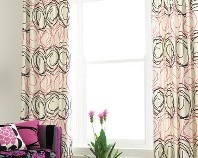Getting a Great Look
 April 2, 2007
April 2, 2007
Q: How Do I Get a Great Look?
Everyone wants a great-looking interior. Design2Share gets questioned a lot about how to confidently select a great look when there are so many styles to choose from. Bottom line: a great look should really thrill and excite you. This episode covers our design pros' advice and tips on how to be aware of your surroundings, where to find inspiration for your next project, how to see what makes certain design elements good or bad, how to make a large project less daunting, how to use travel to inspire your quest for a great look, and how to find interiors that speak to you. Join Irwin and Nicola as they help you "learn to look."
 Design2Share
Design2Share
 Irwin Weiner -- Sometimes I catch myself following in my late father's footsteps. Usually in airports, I indulge in his old habit of purchasing the odd business how-to manual. In one of my favorites, What Clients Love, author Harry Beckwith talks about the FUD Factor. FUD = Fear, Uncertainty, Doubt. He describes a problem facing potential customers as a combination of these three dark horsemen. Oftentimes in my interior design business, I think I'm dealing with a bunch of FUDaholics.
Irwin Weiner -- Sometimes I catch myself following in my late father's footsteps. Usually in airports, I indulge in his old habit of purchasing the odd business how-to manual. In one of my favorites, What Clients Love, author Harry Beckwith talks about the FUD Factor. FUD = Fear, Uncertainty, Doubt. He describes a problem facing potential customers as a combination of these three dark horsemen. Oftentimes in my interior design business, I think I'm dealing with a bunch of FUDaholics.
Historically, European monarchs were happy to spend money on decorating to the point of entire countries going into debt. Louis XIV, the most powerful 17th Century monarch, was never shy about spending design money. The results of his decorating sprees changed the appearance of France. It is now one of the most stylish spots in the world. The French are not genetically more stylish than Americans. They've just been surrounded by good taste and high-end, luxurious decorating elements for centuries. It's rubbed off on the masses.
 My fantasy is that we should all live in perfect environments. All the world would be your stage, and it should be gorgeous. The ultimate compliment I've been given is when one of my clients had a facelift close to the end of our project. "I'm ready for my close-up, Mr. DeMille," she told me. She wanted a beautiful new face to go with her beautiful new surroundings.
My fantasy is that we should all live in perfect environments. All the world would be your stage, and it should be gorgeous. The ultimate compliment I've been given is when one of my clients had a facelift close to the end of our project. "I'm ready for my close-up, Mr. DeMille," she told me. She wanted a beautiful new face to go with her beautiful new surroundings.
I'm egocentric enough to believe that a gorgeous interior will change your life and make you a happier person. But then the FUD Factor hits full on. How do I get my clients to see that I'm right about their decorating direction, that they should relax and trust me more, and that their FUD should evaporate?
Oftentimes I'm in a prospective client interview being told of the difficulties that person has had with the designers they have hired in the past. One prospect had prepared for our initial interview by having fabric samples taped on the walls of her living room. She wanted to hear my opinion regarding the samples she had selected, to see "if you have good taste or not."
Let's just say that these were FUDaholics that I didn't want to turn around. I left these interviews faster than you could say decorate shmecorate.
High-end interior design projects should be enjoyable for both the client and the designer. There are stressful times and difficult moments, to be sure. But like shopping for a new wardrobe, decorating should be mainly fun, enjoyable, and creative for everyone involved. My most difficult jobs usually involve clients unsure of their taste, distrustful of designers, and overly anxious about the end result.
We are all aware of clients who get ripped off by their designers, professionals who won't return client phone calls, so-called professionals who are not well educated in their craft, and others who are not caring and attentive about their work. They only increase the FUD Factor for all homeowners, and I can relate to that. As a professional who wants your high-end decorating experiences to only be smooth sailing, here are a few of my favorite tips to lessen the FUD Factor:
1. Try to be less uptight and more relaxed about the process of hiring a professional interior designer and decorating your home. That's easier said than done, but here's my sound logic. Family squabbles and fights can drag on for years and years. Sometimes they will never end. These problems should make you uptight! Decorating, however, is a project or series of projects with a distinct beginning, middle, and end.
One retired decorator once lamented to me that he left the business because his clients drove him crazy. "It's decorating, not brain surgery!"
My older, experienced clients are more laid back about their projects. They've seen that tension-causing phases of their project soon ease up and wonderful results can be achieved. Many younger clients often get hysterical -- and this is no exaggeration. They have to choose every last detail and micromanage their projects. They are making their lives and their decorators' lives a fresh hell. Shortly before firing a client (yes, decorators often fire clients; meditate on that for a moment), I once asked the wife if she put as much thought and stress into choosing her husband.
2. Pace yourself during your design project. That is the key to overcoming FUD. High-end decorating is not like buying a luxury car. In buying an auto, you choose finishes and luxury details that come prepared from the factory. But your home design project is handmade, customized to your requirements, filled with many complicated variables, and does not come rolling off a factory conveyor belt. This means your project will take more time and more money. There will be mistakes, yes. But a designer with a good reputation and talent will come through for you.
Part of pacing yourself is to embrace the Zen of When. It's better to stop screaming, "When will my table be shipped?" or "When will my pictures be hung?" The Zen of When takes over when you embrace the truth that in the end, it will be worth all the time and inconvenience. Many uncomfortable situations are simply not in your power or in your designer's power to control.
3. Research, research, research. Do you have fear, uncertainty, and doubt about hiring a decorator? Push aside the FUD Factor and do your homework. Now that school is again in session, take a cue from your children and hit the books. Many designers will tell you that most of their clients did not come to them from their published interiors or through advertising. They get the bulk of their new clients from word of mouth. A beautiful interior in a magazine will not tell you one iota of the business practices, acumen, or fairness of a designer. Your friends' honest opinions will reveal much more about who you should hire based on their experiences.
If you don't know of someone whose opinion you can trust, or if you find someone telling you that their decorator is too suspiciously good to be true, ask them a simple question. "If you could change one thing about your designer, what would that be?" Eventually, you'll get to some honesty, which can help you select a professional you can trust, or help you manage your expectations upfront. A well-used resource like the Franklin Report will also give you the opinions of clients who have used recommended interior designers.
My closing remark is upbeat, dear reader. It's time to tell Fear, Uncertainty, and Doubt to FUD off.













Reader Comments (1)
Great vid. I enjoyed the back and forth between the British Isles accents! Looking forward to tuning in each week to get more design advice. Keep them coming.